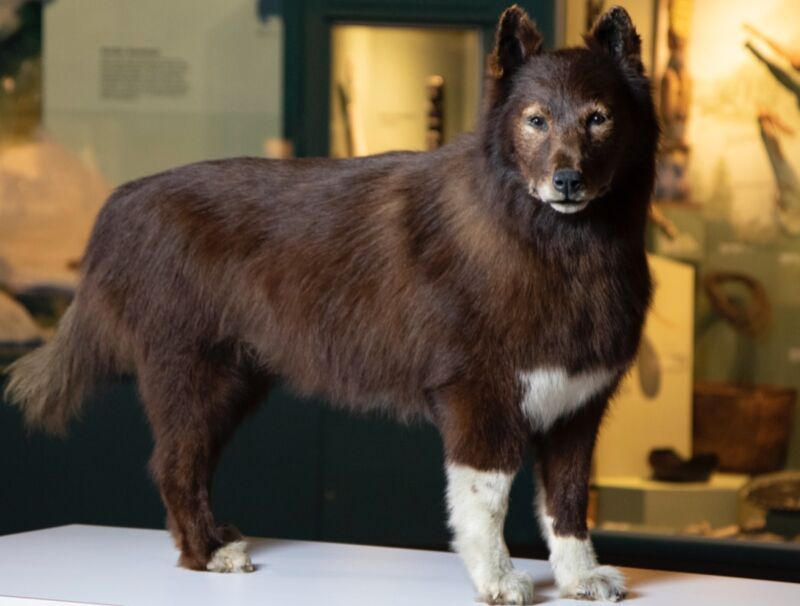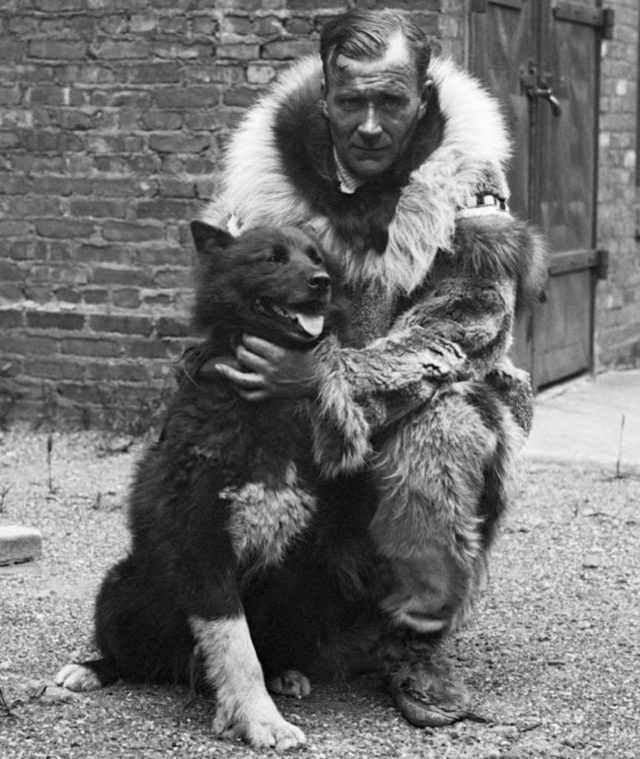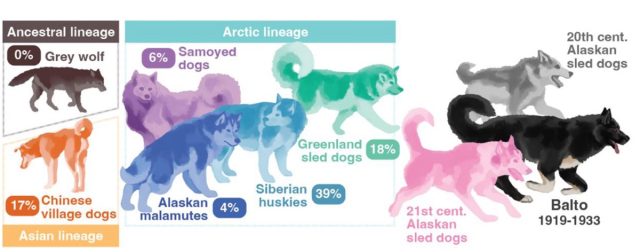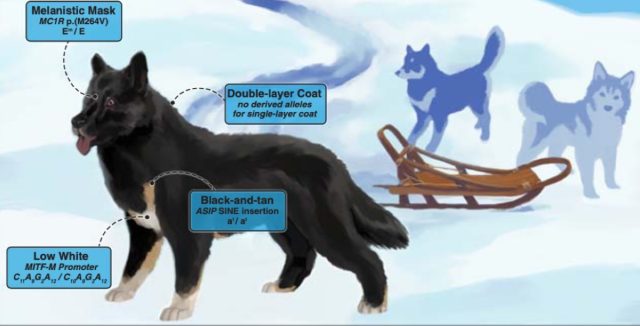
Cleveland Museum of Natural History
In 1925, a sled dog named Balto leads his canine team on the final leg of a grueling 127-hour dogsled relay across Alaska to bring life-saving medicine to the people of Nome—the famous “Serum Run.” Balto is lionized for the act, even inspiring a 1995 animated film and two sequels. Now, scientists have sequenced the dog’s genome for the first time and compared it to modern dog breeds, shedding light on why Balto and similar sled dogs from that era proved so apt to evolve into savages. that winter environment.
It turns out that Balto is only part Siberian husky, and, contrary to popular legend, he is not part wolf. The authors even used the sequenced genome to reconstruct Balto’s physical appearance. These and other findings appear in a new paper published in the journal Science. It is one of several featured in a special issue reporting on results from Zoonomia Projectan international collaboration to sequence and compare the genomes of 240 mammals to discover the genomic basis of traits important for all animals, as well as the changes that underlie the unique traits of individual species.
“The fact that DNA from a small sample of Balto’s skin can provide new scientific insights is a powerful reminder of how advances in science continue to allow us to obtain new information. from museum collections,” said Gavin Svensonchief science officer of Cleveland Museum of Natural History in Ohio, where Balto’s taxidermied remains lie. “Each of the millions of objects in our museum has the potential to reveal an important clue to a future scientist, which in turn can improve our understanding of the past, present, and future of the world around us.”
Balto was born in 1919 to a musher and sled dog breeder Leonard Seppala. Balto was neutered at six months of age because Seppala considered him a “scrub dog,” more muscular and stronger than the small, fast racing huskies that Seppala usually raises and thus better suited to hauling cargo. But the dog would go on to prove his mettle when a severe outbreak of diphtheria hit Nome in January 1925, and the city’s harbor was icebound and therefore inaccessible from the sea.

Public domain
The life-saving serum the residents needed was in Anchorage, some 674 miles away, and the engine of the only available aircraft froze and wouldn’t start. So the officials decided to organize a relay of sled dog teams. The conditions faced by the more than 20 mushers who participated in the Serum Run were brutal, featuring high winds and temperatures of -23° F (-31° C), as well as a blizzard.
A musher named Gunnar Kaasen manages Balto’s team of sled dogs. Kaasen handled the serum package on February 25 in Bluff and drove the sled to Port Safety, where the final team, led by musher Ed Rohn, was supposed to take over for the final leg of the run. Kaasen got there earlier than expected, and Rohn was still sleeping, so Kaasen decided to save time and run the last leg himself, with Balto in the lead. They arrived in Nome at 5:30 the next morning and handed out ampoules of medicine. According to legend, after delivering the medicine, Kaasen hugged Balto and declared him a “damn fine dog.”
It should be noted that there is some controversy as to whether Balto actually led the sled dog team, due to his relative lack of experience in that role, or whether it was led by another dog named Fox. Historic photos and videos of Kaasen with Balto in Nome were recreated hours after their arrival. Rohn and several other mushers thought Kaasen’s decision not to wake Rohn was less altruistic than Kaasen said—that is, he wanted to take all the glory for himself. Even Seppala is not happy with Balto’s sudden celebrity. Seppala is always disappointed with Balto and feels like his dog Togo, who led the other team, deserves equal credit because the Togo team endured the longest and most dangerous part of the run. (Togo got one Disney film in 2019.)

Kathleen Morrill
Alas, fame is fickle and fleeting, even for heroic sled dogs. Balto couldn’t be farmed out as a breeder because he was neutered, so he and his team ended up on the vaudeville circuit. Eventually, Kaasen sold the dogs to the highest bidder to finance his trip back to Alaska. A former prizefighter from Cleveland, George Kimble, found Balto and his team chained in a novelty museum in Los Angeles, mistreated in overcrowded and unhealthy conditions. A furious Kimble organized a successful campaign to raise funds to bring the dogs to Cleveland, where they received a hero’s welcome in March 1927. Balto and the six other dogs in his team lived at Brookside Zoo (later Cleveland Metroparks Zoo) for the rest of their lives.
Balto died of natural causes in 1933, and his remains were mounted by a taxidermist. He has been on display at the Cleveland Natural History Museum ever since, apart from occasional loans—most notably a 1998 five-month stint at the Anchorage Museum of History and Art. His physical remains proved to be important in this latest study. “Balto’s popularity and the fact that he was taxidermied gave us this great opportunity 100 years later to see what the population of sled dogs would look like genetically and to compare him to modern dogs, ” says co-author Katherine Moona paleogenomics postdoc at University of California, Santa Cruz.
After sequencing Balto’s genome, Moon and his co-authors compared it to 682 existing genomes of modern dogs and wolves, as well as an alignment of 240 mammalian genomes developed by the Zoonomia Consortium. That genome alignment tool, developed at UC Santa Cruz, was critical for their analysis. “A gene that is on one chromosome in us is on a completely different chromosome in another species,” says co-author Beth Shapiro, an evolutionary biologist at the university. “You need a tool that can line them up so you can see which parts of these genomes are the same and which are different. Without that, it’s just a bunch of genomes of wildly different species. .”

Kathleen Morrill
The results showed that Balto is only part of the Siberian husky, with additional ancestry related to Alaskan sled dogs, village dogs, Greenland sled dogs, and Tibetan mastiffs. His population of working sled dogs was more genetically diverse than modern Siberian huskies, and those genetic variants may be why Balto and his ilk are so well equipped to thrive in the harsh environment of Alaska in the 1920s. For example, Balto has genetic variants related to weight, coordination, joint formation, and skin thickness, according to Moon. And Balto could digest starch better than wolves and Greenland sled dogs, though not like modern dogs.
As for the reconstruction of Balto’s appearance, analysis of relevant known genetic variants is consistent with Balto’s smaller stature and atypical coat features, as seen in historical photographs and his taxidermied remains. His coat is double-layered and mostly black, with some white on his chest and legs. While Balto’s genome has alleles for light-tan pigmentation and blue eyes, the authors say “both are masked by his melanistic facial mask.”
“It’s amazing to see the evolution of dogs like Balto, even over the last 100 years,” Moon said. “This project gives everyone an idea of what’s starting to become possible as more high-quality genomes become available to compare. It’s an exciting moment because these are things we haven’t done yet. For I’m an explorer, and once again Balto leads the way.”
DOI: Science, 2023. 10.1126/science.abn5887 (About DOIs).
